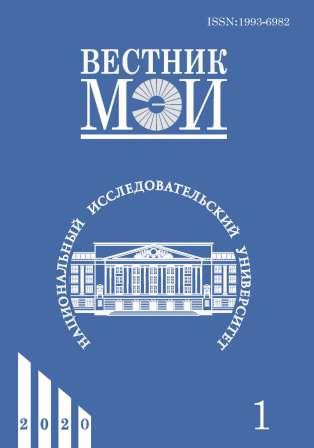Способ эффективного управления электроприводом штангового глубинного насоса
Аннотация
Представлены результаты разработки нового способа управления частотно-регулируемым электроприводом штангового глубинного насоса (ШГН) с асинхронным двигателем. Цель разработки — повышение энергетической эффективности работы электропривода ШГН за счет снижения потребления электроэнергии в рабочем цикле. Снижение энергопотребления обеспечивается посредством использования кинетической энергии неуравновешенных механических частей насоса, которые совершают возвратно-поступательное движение в вертикальной плоскости. Для реализации указанного принципа в электроприводе ШГН, работающего по системе преобразователь частоты - асинхронный двигатель, предложено использовать не постоянный сигнал задания на скорость вращения вала двигателя, а периодически меняющийся сигнал.
Дано аналитическое обоснование эффективности подобного решения, основанное на учете баланса кинетической и потенциальной энергий в рабочем цикле перемещения штанги глубинного насоса. Приведены математические выражения, исходя из которых, должен формироваться требуемый сигнал задания скорости, обеспечивающий снижение потребления электроэнергии электроприводом насоса. Схемотехнически ожидаемый эффект может быть обеспечен путем применения специального вычислительного устройства (контроллера), подключенного к управляющему входу преобразователя частоты электропривода насоса. Он будет выполнять функцию специализированного задатчика скорости движения штанги и поршня. Устройство должно быть дополнено датчиком положения, установленным на валу кривошипа установки ШГН и передающим сигнал о направлении движения штанги насоса в контроллер задатчика скорости. При опускании штанги насоса задание скорости будет плавно увеличиваться, обеспечивая рост запаса кинетической энергии, а при подъеме штанги — плавно уменьшаться, обеспечивая полезный расход запасенной кинетической энергии. Таким образом, при использовании предлагаемого способа управления уменьшается поток энергии, проходящий через двигатель и преобразователь частоты при неизменном объеме механической работы насоса. Именно этим и определяется повышение энергоэффективности технологической установки.
Литература
2. Brandt A.R. Oil Depletion and the Energy Efficiency of Oil Production: The Case of California // Sustainability. 2011. V. 3. No. 10. Pp. 1833—1854.
3. Vazquez M. e. a. Global Optimization of Oil Production Systems. A Unified Operational View // Proc. SPE Ann. Techn. Conf. and Exhibition. Soc. of Petroleum Eng., 2001.
4. Langbauer C., Winkler T. Frequency Elastic Drive System Operation O
of Sucker Rod Pumping System // Proc. 17th Intern. Ural Conf. AC Electric Drives (ACED). 2018. Pp. 1—5.
5. Khakimyanov M.I., Shafikov I.N., Khusainov F.F. Control of Sucker Rod Pumps Energy Consumption // Intern. Siberian Conf. Control and Communications. 2015. Pp. 1—4.
6. Шабанов В.А. Основы регулируемого электропривода основных механизмов бурения, добычи и транспорта нефти. Уфа: Изд-во УГНТУ, 2009. С. 123—136.
7. Пат. № 2686304 РФ. Способ управления частотно-регулируемым электроприводом штангового глубинного насоса с асинхронным двигателем / А.Н. Ладыгин, Д.Д. Богаченко, Н.А. Ладыгин, В.В. Холин // Бюл. изобрет. 2019. № 12.
--
Для цитирования: Ладыгин А.Н., Богаченко Д.Д., Ладыгин Н.А., Холин В.В. Способ эффективного управления электроприводом штангового глубинного насоса // Вестник МЭИ. 2020. № 1. С. 49—54. DOI: 10.24160/1993-6982-2020-1-49-54.
#
1. Khakim'yanov M.I., Shafikov I.N. Analiz Potrebleniya Elektroenergii pri Mekhanizirovannoy Dobyche Nefti Elektrotsentrobezhnymi Nasosami. Elektrotekhnicheskie i Informatsionnye Kompleksy i Sistemy. 2013;9;3:37—41. (in Russian).
2. Brandt A.R. Oil Depletion and the Energy Efficiency of Oil Production: The Case of California. Sustainability. 2011;3;10:1833—1854.
3. Vazquez M. e. a. Global Optimization of Oil Production Systems. A Unified Operational View. Proc. SPE Ann. Techn. Conf. and Exhibition. Soc. of Petroleum Eng., 2001.
4. Langbauer C., Winkler T. Frequency Elastic Drive System Operation of Sucker Rod Pumping System. Proc. 17th Intern. Ural Conf. AC Electric Drives (ACED). 2018: 1—5.
5. Khakimyanov M.I., Shafikov I.N., Khusainov F.F. Control of Sucker Rod Pumps Energy Consumption. Intern. Siberian Conf. Control and Communications. 2015:1—4.
6. Shabanov V.A. Osnovy Reguliruemogo Elektroprivoda Osnovnykh Mekhanizmov Bureniya, Dobychi i Transporta Nefti. Ufa: Izd-vo UGNTU, 2009:123—136. (in Russian).
7. Pat. № 2686304 RF. Sposob Upravleniya Chastotno-reguliruemym Elektroprivodom Shtangovogo Glubinnogo Nasosa s Asinkhronnym Dvigatelem. A.N. Ladygin, D.D. Bogachenko, N.A. Ladygin, V.V. Kholin. Byul. Izobret. 2019;12. (in Russian).
--
For citation: Ladygin A.N., Bogachenko D.D., Ladygin N.A., Kholin V.V. A Method for Efficiently Controlling the Sucker-Rod Pump Electric Drive. Bulletin of MPEI. 2020;1:49—54. (in Russian). DOI: 10.24160/1993-6982-2020-1-49-54.




